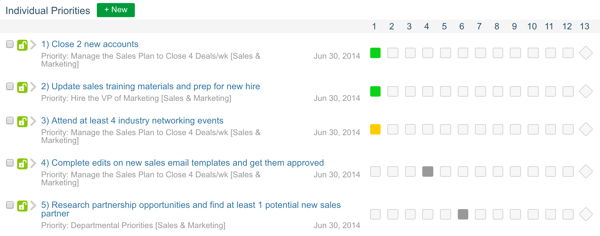If you regularly follow our blog, you know we believe in using Red-Yellow-Green® status criteria as a critical  element of creating a plan with clear expectations around what exactly it is you are going to accomplish. Setting success criteria is not only vital to ensuring that your plan makes sense to others, it is also key to the successful execution of your plan. After all, how can you achieve something without knowing what success and failure look like? Red-Yellow-Green is about clarity around the goals, and also about accountability to achieving those goals. When you have to update and share your status weekly, you are far more likely to achieve success.
element of creating a plan with clear expectations around what exactly it is you are going to accomplish. Setting success criteria is not only vital to ensuring that your plan makes sense to others, it is also key to the successful execution of your plan. After all, how can you achieve something without knowing what success and failure look like? Red-Yellow-Green is about clarity around the goals, and also about accountability to achieving those goals. When you have to update and share your status weekly, you are far more likely to achieve success.
If you are a Rhythm software user, you also know that there’s more to it than “Red-Yellow-Green.” In the software, you also have the option to set SuperGreen or Gray statuses when you are updating your dashboard weekly. Once again, if you’re a regular on our blog, you’ve probably heard us talk about SuperGreen. That’s your stretch goal, the goal you set so that your A-Players have something to shoot for above what already would be considered success.
So, that leaves Gray. What the heck is that for? A Gray status in Rhythm means “Not Started.” You might be thinking, yikes - why is that even an option? And, if you are in Week 7 of your 13-Week Race and still marking things Gray on your dashboard, “Yikes!” is the appropriate response.
When used correctly, however, Gray can be a tool to help you manage your energy more effectively for the quarter. The idea behind the Gray status is not that you just keep hitting Gray week after week. “Nope, didn’t have time to start that priority yet… Still Gray.” That would not be good. The best practice is to go into Rhythm in Week 1 and put in a Gray status on the week number that you think you’ll actually start working on that priority.
Here's an example:
Let’s say you have five priorities on your dashboard for this quarter. Three of them you start working on right away (or maybe they are ongoing things that you’re always working on). For those, you can go in and give a pretty accurate forecast of whether or not you’re on track to hit the goal by the end of the quarter. You can status Red, Yellow, Green or SuperGreen.
But, what about those other priorities? Let’s say one of them is dependent on another department or another person. If you have a priority that you can’t start working on until someone else gives you their part of the project, you might not know how to status that item in Week 1. You probably would just be guessing at how you’d end up at the end of the quarter and not be able to make a very accurate forecast. But, what you could do is think, “If I don’t have what I need from Megan by Week 4, there’s no way I will get my priority done.” So, in this example, you’d want to mark the priority status for Week 4 Gray. And, of course, you’d want to collaborate with Megan to make sure her deadlines are aligned with yours so that you set yourself up for success on the project. Now, you have a visual indicator on your dashboard for when you are set to start that project. And, if Week 4 rolls around and Megan’s part of the project is not on your desk, you know that you are officially Yellow or Red because you determined that a “Not Started” status after that point would get you into trouble! You can raise your hand and work on adjustments with the team now rather than keep that Gray status going for another few weeks.
Let’s talk about another example when you might use the Gray status. Maybe your fifth priority isn’t necessarily dependent on another person (or even an event on the calendar that would trigger the start of your work on a priority). Being aware of your time and the energy you are expending on each of your priorities, perhaps you determine that you won’t have the bandwidth to even start on the last one until later in the quarter. If you have determined all the milestones for completing that priority and know that nobody else on the team is waiting for you to finish it up early, you may determine that this priority is going to take you six weeks. And, you may know that you won’t have time to start on it until Week 6. Instead of taking your mental bandwidth to update the status weekly on something that you know you won’t start until later, go ahead and mark Week 6 gray on your dashboard in Week 1. That way, you can manage your energy better for the quarter and have your dashboard reflect the work you’re actually doing now to drive your priorities forward.
One word of caution - be careful with any “Not Started” statuses after Week 6. The pattern we’ve seen is that if you haven’t started by then, it’s likely that it's just not going to happen this quarter. So, use your Gray status wisely!
Want to learn more about setting effective Red-Yellow-Green success criteria? Check out this funny video our team made.
Photo Credit: iStock by Getty Images



